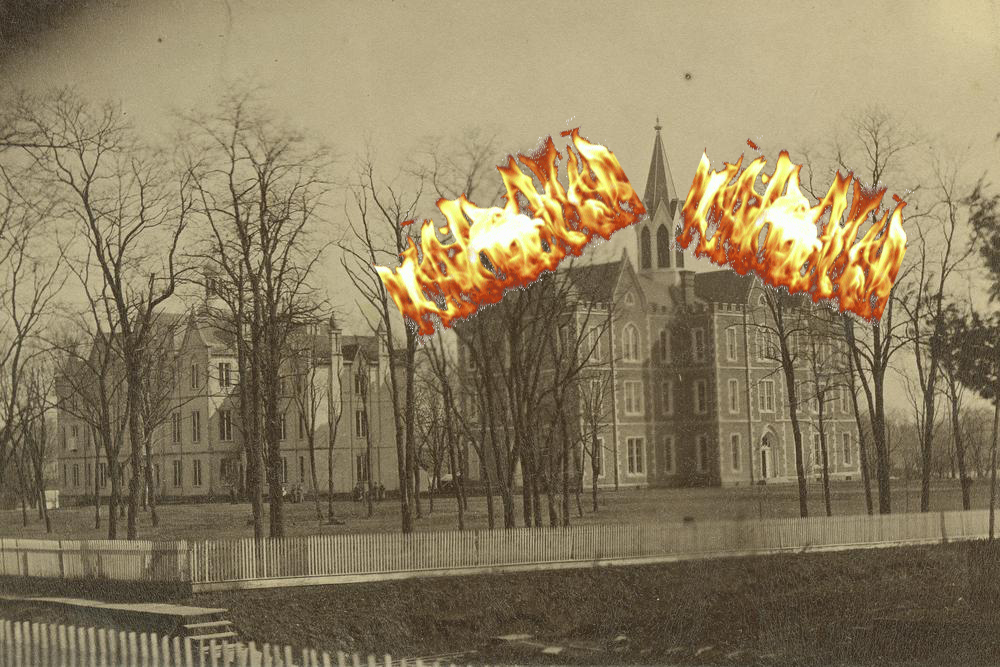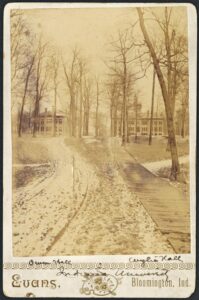Today is the anniversary of the most destructive and institution-altering fire in Indiana University’s history. Read below for details and for more info other Bloomington campus fires, see Ava’s post from June 22!

On July 24th, 1883, the IU Board of Trustees met for the first time since the fiery destruction of their campus to discuss the future of the university. After reading a number of letters of sympathy from alumni and presidents of nearby colleges, the Board determined their immediate courses of action: clear the debris of the burned building, salvage any potential building or educational materials from the wreckage, begin planning construction for a new science building and library.
The IU faculty minutes from just after the incident capture the chaos of the fire, the cause of which was later found to be a lightning strike to the telephone wire that led to Theophilus Wylie’s room:
On the night of Thursday July 12th 1883 a little after 10 o’clock, the new college building was found to be on fire and the alarm was given. As the crowds gathered, the flames were seen bursting out from the second story, from the room used for storing apparatus and as a work room on the East side. The Fire Dept. of the town with its new steam fire engine, and its smaller engine, did its best to extinguish the flames. In this attempt it failed but succeeded by energetic work in saving the old building by keeping the roof and end adjacent to the burning structure soaked with water. Within two hours from the discovery of the fire, the entire roof had fallen in and only the walls with a few clinging timbers remained. The building thus destroyed was three stories in height and was built in 1873 at a cost of $33,000. It contained the Library of 14000 volumes the Museum in which was the Owen Cabinet of 85000 specimens carefully labeled and displayed in suitable cases. The Ward caste of Extinct Animals and many other valuable collections. In the third story was Prof. Jordan’s collection of fishes.
While not the only fire in IU history, as illustrated in part one of this post, the 1883 fire was by far the most significant, both financially and culturally. Though different sources list varying estimates of the fire’s damage, the Indiana Student of January 1885 states a total loss of $104,200. This number, of course, does not account for the irreplaceable artifacts and books lost, including a number of unique volumes and manuscripts related to Indiana history. The Board explored a number of tactics to raise the $77,000 that they determined was necessary to rebuild the campus and repopulate its laboratories and library. Proposals included doubling Monroe County citizens’ taxes for a year to soliciting donations from alumni. The first donation, a gift of $5 from Sarah Morrison, IU’s first female student and graduate of IU, was used to purchase a new minute book for the Board of Trustees’ meetings, as the previous book had been lost in the fire. Through this variety of means, the university obtained an astonishing $50,000 from the county’s citizens, illustrating Bloomington’s overwhelming support of the institution and allowing the university to boast that it had rebuilt without “taking a penny” from government funds. The insurance received after the disaster accounted for the remaining $77,000 and allowed IU to begin construction on its two initial buildings on the now relocated campus: Wylie Hall, devoted to chemistry and physics, and the smaller Owen Hall, dedicated to the natural sciences.

Though many irreplaceable specimens and volumes were lost to the flames, the incident provided the university with an opportunity to expand and develop its campus and to re-evaluate its role in Indiana’s higher education. Established as the Indiana Seminary by an act of legislation in 1820, the institution that opened its doors in 1825 became Indiana College in 1828 and Indiana University in 1838. As the student population and their interest in the sciences grew, IU began to want for more classroom and laboratory space as well as housing for their increasing library collections. The 1883 fire provided the opportunity to move the campus away from the noisy rail-way bordering the west side of the Seminary Square campus and into the scenic and spacious Dunn’s Woods, where the university had purchased a 20-acre plot for $300 per acre. The destruction of the campus prompted a minor (and unsuccessful!) movement to consolidate IU, the State Normal School and Purdue University. Luckily, the resulting outcry, which argued that IU needed to remain a “strictly literary institution” to complement the focus on “agricultural and mechanical industries” of Purdue and on teacher training at the Normal School, convinced community and Board members alike to continue to support Indiana University as an independent institution.
Leave a Reply